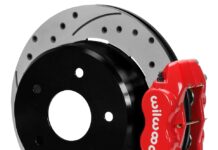Hot Rod Hero Bob Bauder’s Enduring Influence
By Eric Geisert – Photography By Wes Allison
In February 2018, the NHRA Museum in Pomona, California, was packed with folks who were there for one thing: to honor the memory and life of Bob Bauder. Outside the facility the parking lot was full of the legacy Bob was so well known for: An exceptional group of cars he had built (fully or had-a-hand-in/on) over the previous five decades.

Though the collection was as varied as their current owners, they all had one thing in common besides Bob’s handiwork: They were all pure hot rods. Real-deal hot rods aren’t as prevalent nowadays as there may be too much emphasis placed on creature comforts but, rest assured, when Bob built a ride for either himself or a customer, each car was going to be a handful, and it was going to profile better than anything else around it.

Read More: Traditional 1930 Model A Sedan With A Twist
Bob was, for the most part, a well-known secret in the early days of street rodding—the most famous guy you probably haven’t ever heard of. But he built fine hot rods alongside the best of them, such as Boyd Coddington, Bob Thelen, Barry Lobeck, Chuck Lombardo, or Lil’ John Buttera, but he had zero interest in being in the limelight.

But Bob’s connections allowed for some of the most memorable and recognizable hot rods ever to be built, among them Vern Luce’s coupe (Bob introduced Luce to Coddington), he was involved with the creation of Jerry Moreland’s “World’s Fastest ’40” Ford sedan, and teamed with Pete Chapouris on the 30-day builds of the HogZZilla motorcycles for ZZ Top’s Billy Gibbons. Bob was also the one who turned collector Bruce Meyer onto Pete Chapouris and that was only one of the reasons Chapouris had said Bob was “instrumental” in helping him become the icon he was.

Through the decades, Bob was always on the lookout for another Deuce to build for himself (he’s done several in his time) and had collected a lot of parts here and there, but thought the time was right for a 1932 Model A pickup.

For this build Bob used an Al Simon frame to make his own four-bar front suspension (with a mono leaf) as well as a triangulated rear setup. A Ford 8-inch rear end (3.23:1), with Currie Enterprises Axle and Romic coilover shocks would go in finished with 8-inch drums. Up front 1941 Lincoln brakes were used (topped with Buick drums) along with a Vega steering box connected to a 1955 Corvette steering column and a 1958 Corvette steering wheel. The wire wheels came from Wheelsmith and are 15-inchers (6s and 8s) shod in BFGoodrich tires.

Read More: Michael Frotten’s LT4 Supercharged 1965 Chevy Impala SS
Many of Bob’s past rides had an abundance of horsepower at the ready, but the motor in this pickup, a ’67 327, was built to be a driver, with a single AFB carburetor up top. Seven-fin Corvette valve covers, a Ram Horn exhaust manifold to mufflers outfitted by Scotty’s Muffler in San Bernardino, California, and a 140-amp alternator were just some of the additions.

Bob said the cab of the truck was a “true barn find,” and it came from Wisconsin. A set of 25-louver hood sides were found and Bob tracked down a pair of scratch-built rear fenders that were in very good shape. He then turned the metal parts over to Dakota Wentz of Star Kustom Shop in Riverside, California, so he could start on the custom fabrication, which included removing some of the rivets in the bed and reskinning a portion of the driver door. Wentz sprayed the cab, repro bed, and wire wheels with the PPG paint codes Bob gave him, then painted the fenders and some extra accents in a gloss black. It was all followed up with a red pinstripe down the body reveals and, on the trunk, found in the bed (a 1930s Potter Mfg. trunk that holds Bob’s tools and cleaning stuff).

There wasn’t much chrome on the pickup, but what was dipped was done by MJB Chrome Plating in San Bernardino. The interior is highlighted by an Auburn dash with an engine-turned panel that uses five Stewart Warner gauges to tell Bob what is going on. Up on the header is a Sandoz-Vuille mirror-mounted clock (an accessory available in the 1930s), and just in front of the bench seat is a tall Gennie shifter topped with an Akron marble shifter ball (Editor’s note: Look up Akron marbles online). Louis Valenzuela, who runs Louis Valenzuela Upholstery in Victorville, California, got the call to stitch Bob’s custom interior, which included Mercedes carpet and maroon leather for the bench and headliner.

All in all, it took about 10 months for Bob to finish his ride, but it would be his last in a long line of wonderful cars as he died in September 2017. In the last couple years of his life, Bob had become friends with Larry Jacinto as the two had started building Larry’s Willys pickup.

Read More: The Ultimate Buick Riviera Build?
But a few months after Bob’s death, Larry contacted the Bauder family as he was interested in buying the 1932 pickup, keeping the memory of Bob alive, and preserving an example of Bob’s hot rodding style. Looking back now, Larry thinks of Bob as a hot rod hero (something Bob would no doubt quickly deny), so having Bob’s truck in his garage is a great way to remember their friendship as well as preserve his legacy. MR











































